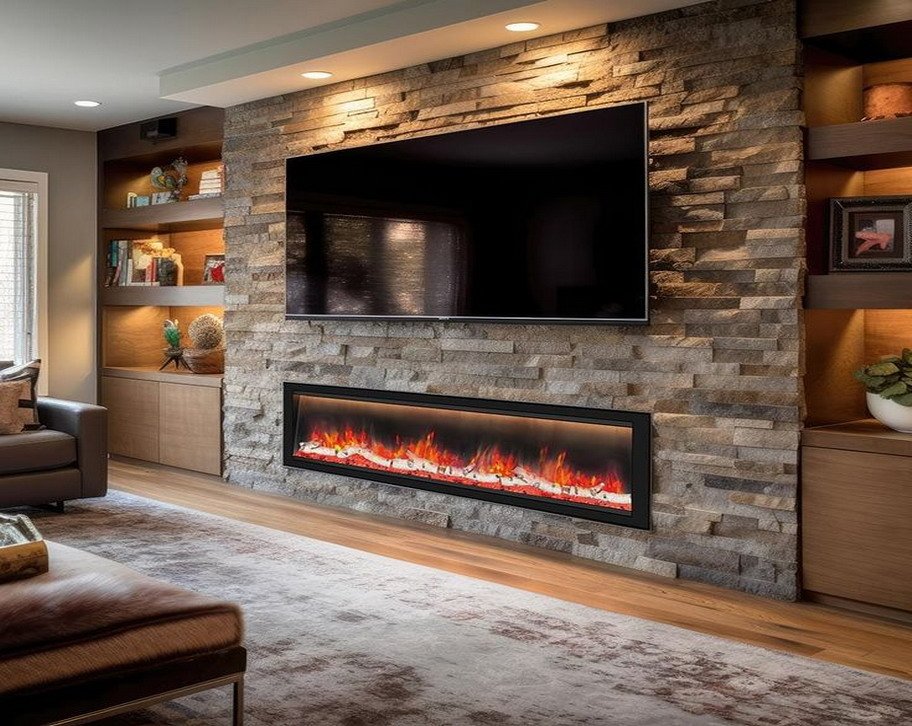Are you looking at your old brick fireplace and dreaming of a fresh, modern look? Installing stone veneer over your existing brick fireplace can give your home that stunning makeover you’ve been wanting. This fireplace transformation doesn’t require tearing down your current structure, making it a cost-effective solution for homeowners.
Stone veneer installation offers a perfect way to refresh your traditional brick fireplace without the mess and expense of a complete rebuild. You can choose from natural stone or manufactured stone veneer, both providing beautiful options to create a stunning focal point in your living space.
Let’s walk through everything you need to know about adding stone veneer to your existing brick fireplace.

Yes, you can put stone veneer over brick, and it’s a fantastic way to update your fireplace! The key is ensuring your existing brick fireplace is in good condition before starting the masonry transformation. A solid brick surface provides the perfect foundation for your new stone facade overlay.
Your existing brick surface needs careful inspection before installing the stone veneer. Look for any loose mortar, cracks, or damage that might affect the installation process. A wire brush can help clean the surface and remove any debris that could interfere with proper adhesion.
This fireplace remodeling technique saves both time and money compared to completely rebuilding. Natural stone veneer or manufactured stone veneer can be applied directly to the brick, creating a stunning focal point that adds value to your home.
Just remember to check that your fireplace structure can handle the extra weight of the stone product.
Before you install stone veneer over your existing brick fireplace, a thorough inspection is required. Check your brick wall for any signs of deterioration, as the masonry foundation needs to be solid enough to support both the existing brick and the new stone veneer.
Start by cleaning your brick surface thoroughly. Using a wire brush, remove any loose mortar or debris. Your old brick needs to be free from any damage or crumbling areas that could compromise the installation. A clean, stable surface ensures proper adhesion for your fireplace makeover.
The next step involves applying a scratch coat of mortar to create a solid base. Using a trowel, spread this bonding layer evenly across the brick surface. Whether you’re planning to install natural stone or faux stone veneer, this preparation ensures your stack stone will adhere properly and create a lasting transformation.
Start by evaluating your brick fireplace’s condition. Look for any signs of damage, loose mortar, or structural issues. A thorough inspection ensures the surface is suitable for stone veneer installation.
Gather essential tools like a wire brush, trowel, level, and appropriate mortar mix. Clean the brick surface thoroughly and apply a quality bonding agent. This creates a strong foundation for the stone veneer to adhere properly.
Following manufacturer guidelines, apply mortar to both the prepared brick surface and the back of each stone piece. Press stones firmly into place, maintaining consistent spacing and patterns. Always check local building codes to ensure your installation meets safety requirements.
Remember to work from bottom to top, using spacers for even gaps. Allow proper drying time between steps and clean any excess mortar from stone faces as you progress.
Stone cladding instantly modernizes outdated brick fireplaces, creating a stunning focal point in any room. This transformation can dramatically increase your home’s visual appeal and value. The versatile nature of stone veneer allows you to completely reinvent your fireplace’s appearance.
Choose from diverse design styles to match your home’s aesthetic. Modern homes benefit from sleek, stacked stone in contemporary grays or whites. For rustic appeal, opt for natural fieldstone or river rock. Traditional spaces shine with classic cut stone patterns in timeless neutral tones.
The right stone cladding combination can set the perfect mood for your space. Light-colored stones brighten rooms and create an airy feel, while darker tones add drama and sophistication. Textured stones add depth and visual interest, while smooth finishes offer elegant simplicity.
Regular maintenance is key to preserving your stone-clad fireplace’s beauty and functionality.
Your fireplace should be the heart of your home, warm, inviting, and visually striking. At Atlantic Brick and Stone, we specialize in transforming outdated brick fireplaces into stunning focal points using high-quality stone veneer.
With durable materials and expert craftsmanship, your new stone-clad fireplace will enhance both the beauty and value of your home.
Don’t wait to make your living space feel brand new, book your stone veneer installation in Fredericton today and experience the difference professional stonework can make.
In most cases, removal isn’t necessary. As long as your brick surface is solid and free from damage, stone cladding can be installed right on top.
Popular options include natural stone veneer, cultured (manufactured) stone, and stacked stone panels. Natural stone gives an authentic look, while manufactured stone is lighter and easier to install.
Most transformations can be completed within 2 to 4 days, depending on the size of the fireplace and drying time for adhesives or mortar.
Simply use a soft brush or vacuum to remove dust. Avoid harsh cleaners—mild soap and water are usually enough to keep your stone looking beautiful.
GET STARTED
Create stunning structures with our residential and commercial masonry services in Fredericton. From meticulous designs to the completed build, our process is professional and rewarding, and we can’t wait to build your dream with you.
Atlantic Brick and Stone, one of the best masonry contractors in Fredericton, NB
Contact
8 Muskie Street, Lower Kingsclear, New Brunswick E3E 0E7, Canada